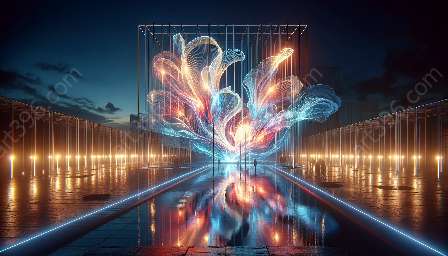Light art, with its ephemeral and transient nature, poses unique ethical considerations for artists. As creators of temporary light installations, artists bear ethical responsibilities that extend beyond their artistic vision. This article delves into the ethical dimensions of light art and examines artists' roles in preserving and documenting their temporary creations.
The Ethical Landscape of Light Art
Light art represents an intersection of creativity, technology, and environmental consciousness. Artists working in this medium often challenge conventional perceptions of space, time, and perception, prompting viewers to engage with their surroundings in new and meaningful ways. However, the impermanence of light art presents a paradoxical ethical challenge: how can artists balance the desire to create ephemeral experiences with the responsibility to preserve their works for future audiences?
At the heart of this ethical landscape is the tension between impermanence and documentation. Artists must grapple with questions of legacy, conservation, and ownership as they navigate the temporality of their installations. Furthermore, the environmental impact of light art is an increasingly relevant consideration, as artists strive to minimize their ecological footprint while creating compelling visual experiences.
Preserving Temporality: Artists' Ethical Responsibilities
Artists engaged in light art are confronted with the necessity of preserving their installations in a manner that upholds both artistic integrity and ethical standards. The act of preserving light art involves not only capturing its visual essence but also honoring the intangible qualities that define its temporality. Preservation efforts must respect the original intent of the artist and avoid compromising the essence of the transient experience.
Documentation, in the form of photography, videography, and written records, plays a central role in fulfilling artists' ethical responsibilities. Through comprehensive documentation, artists can ensure that their ephemeral works are commemorated and shared with future audiences. Moreover, the ethical use and distribution of documentation aligns with principles of transparency, accessibility, and cultural preservation.
Ethical Considerations in Light Art
Examining the ethical considerations in light art involves exploring themes of inclusivity, public engagement, and the democratization of art. Artists are tasked with creating experiences that are respectful of diverse audiences and inclusive of different perspectives. In this context, ethical decision-making extends beyond the creation and preservation of light art to encompass the accessibility of these experiences for all individuals.
Furthermore, the ethical dimensions of light art intersect with broader societal conversations about public space, technological advancement, and the responsible use of resources. Artists must navigate ethical complexities related to public safety, environmental impact, and the equitable distribution of artistic experiences. These considerations shape the ethical framework through which artists approach the conception, execution, and preservation of their light installations.
Conclusion
The ethical responsibilities of artists in preserving temporary light installations are multifaceted and integral to the evolving landscape of light art. As creators and stewards of ephemeral experiences, artists are called to uphold ethical principles that honor the transient beauty of their works while engaging with the complexities of documentation, environmental impact, and inclusive public engagement. By navigating this intricate ethical terrain, artists contribute to the enrichment of cultural discourse and inspire meaningful connections between art, technology, and humanity.

